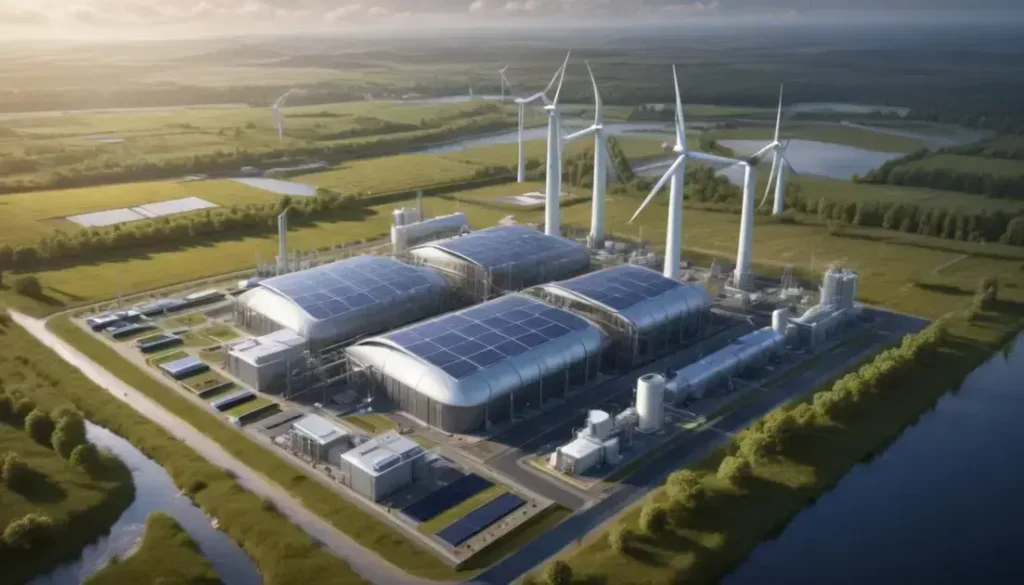Sustainability in manufacturing focuses on integrating renewable energy, optimizing resource use, and enhancing operational efficiency, while fostering collaboration among industries to reduce waste and improve environmental impact.
In today’s rapidly evolving landscape, sustainability has become a crucial focus for industries worldwide. How are leaders like Eaton reshaping manufacturing practices?
Overview of Eaton’s sustainability approach
Eaton’s sustainability approach is centered on the principle of energy efficiency and environmental responsibility. This strategy encompasses innovative methods to reduce waste, conserve resources, and promote cleaner manufacturing processes. Eaton aims to integrate renewable energy sources into its operations, significantly decreasing its carbon footprint and enhancing the overall sustainability of its production facilities.
One of the key initiatives includes the “Factories as a Grid” concept, where Eaton transforms traditional manufacturing plants into energy hubs. This allows factories to not only consume energy but also generate and store power. By leveraging advanced technologies such as energy storage systems, Eaton can manage energy flow effectively, turning its plants into efficient, self-sustaining environments.
Moreover, Eaton’s commitment to sustainability is reflected in its partnerships with local communities and other companies. This collaborative approach fosters shared goals towards innovation in sustainable practices. As a result, Eaton not only enhances its operational efficiency but also contributes positively to the communities where it operates, demonstrating a comprehensive approach to sustainability.
Understanding the ‘Factories as a Grid’ strategy
The “Factories as a Grid” strategy is a revolutionary approach that redesigns traditional manufacturing facilities into dynamic energy management systems. This concept empowers factories to produce, store, and share energy efficiently, transforming them into integral components of the broader energy ecosystem. With this model, plants become less reliant on external power sources, contributing to energy resilience.
By incorporating renewable energy technologies, such as solar panels and wind turbines, factories can harness clean energy while minimizing costs. Furthermore, integrating sophisticated energy management systems allows real-time monitoring and optimization of energy use. This not only improves operational efficiency but also reduces the overall carbon footprint.
The strategy promotes enhanced collaboration between different facilities. Factories can exchange excess energy, creating a network that maximizes resource utilization. Such synergy fosters innovation and leads to increased sustainability, benefiting both the environment and the companies involved.
Ultimately, the “Factories as a Grid” initiative represents a significant step towards a sustainable future. By reimagining the way factories interact with energy resources, this strategy paves the way for a more resilient and efficient manufacturing landscape.
Benefits of renewable energy integration
The integration of renewable energy into manufacturing processes offers a range of significant benefits. Firstly, it enhances energy efficiency, allowing companies to reduce their overall energy consumption and costs. By utilizing sources such as solar, wind, and hydroelectric power, manufacturers can secure a more sustainable energy supply that is less susceptible to price fluctuations.
Moreover, adopting renewable energy supports companies in meeting regulatory compliance related to environmental standards. As governments increasingly mandate reductions in greenhouse gas emissions, utilizing clean energy sources helps businesses align with these regulations while enhancing their market reputation.
Another key advantage is the potential for increased operational resilience. Manufacturing facilities that generate their own energy can mitigate disruptions caused by grid failures or supply chain issues. This self-sufficiency not only secures production capabilities but also fosters innovation in energy management.
Additionally, consumers today are more conscious of the sustainability practices of the companies they support. By integrating renewable energy, businesses can enhance their brand image and attract environmentally aware customers, leading to improved customer loyalty and market share.
Impact on Canadian manufacturers
The impact of Eaton’s sustainability initiatives on Canadian manufacturers is significant and multifaceted. As companies strive to meet environmental regulations and consumer expectations, manufacturers that adopt sustainable practices position themselves as industry leaders.
One of the primary benefits is the enhancement of operational efficiency. By integrating renewable energy sources and adopting innovative energy management systems, Canadian manufacturers can lower their energy costs while minimizing their carbon footprint. This shift not only meets regulatory demands but also appeals to environmentally conscious consumers.
Moreover, the push for sustainability fosters innovation. Manufacturers are encouraged to develop new processes and technologies that reduce waste and increase resource efficiency. This drive for improvement leads to greater competitiveness in both national and global markets.
Additionally, sustainability initiatives can result in improved brand reputation. Companies that prioritize environmental stewardship gain recognition and loyalty from customers who prefer brands that share their values. As public awareness of climate change grows, Canadian manufacturers adopting these practices are likely to attract new business opportunities.
Case study: Arecibo plant insights
The Arecibo plant serves as a compelling case study in implementing sustainable practices in manufacturing. As part of Eaton’s commitment to sustainability, this facility has adopted several innovative strategies aimed at reducing its environmental impact.
One significant initiative is the integration of renewable energy sources. The Arecibo plant has installed solar panels that significantly contribute to its energy needs, reducing reliance on non-renewable energy. This shift not only decreases operating costs but also aligns with global trends towards clean energy.
Additionally, the plant utilizes advanced energy management systems to monitor and optimize energy consumption in real-time. This technology enables the facility to reduce waste and operate more efficiently, which is crucial in today’s competitive manufacturing landscape.
Employee training programs at Arecibo also emphasize sustainability. Workers are encouraged to identify opportunities for efficiency improvements, fostering a culture of innovation and responsibility. This comprehensive approach not only enhances productivity but also reinforces the importance of environmental stewardship.
Challenges in energy management
Energy management presents a variety of challenges for manufacturers striving to achieve sustainability goals. One primary hurdle is the integration of renewable energy sources into existing systems. Transitioning from traditional energy sources to solar or wind can involve significant initial costs and require extensive modifications to current infrastructure.
Furthermore, managing diverse energy inputs creates complexities in maintaining consistent energy supply. Fluctuations in renewable energy availability can lead to operational disruptions if not carefully balanced with demand. This necessitates advanced energy management systems that can adapt to changing conditions in real-time.
Another challenge is the need for staff training. Employees must understand new technologies and practices, necessitating ongoing education in sustainability initiatives. A lack of knowledge can hinder the successful implementation of energy management strategies and restrict innovation.
Additionally, regulatory compliance can be daunting. As governments impose stricter environmental regulations, manufacturers face the pressure of keeping up with the evolving legal landscape while ensuring they do not compromise their operational efficiencies.
Future trends in manufacturing sustainability
Future trends in manufacturing sustainability are poised to reshape the industry landscape dramatically. One of the most promising directions is the increasing adoption of smart manufacturing technologies. These innovations leverage the Internet of Things (IoT) and artificial intelligence (AI) to optimize production processes and enhance resource efficiency.
A crucial aspect of these technologies is their ability to monitor energy consumption in real-time. By analyzing data, manufacturers can identify inefficiencies and implement corrective measures swiftly. This proactive approach leads to better energy management and reduced operational costs.
Moreover, the emphasis on circular economy principles is likely to grow. Companies are exploring ways to minimize waste by reusing materials and recycling products at the end of their lifecycle. Such practices not only lower production costs but also help fulfill consumer demand for sustainable practices.
Another trend is the focus on collaboration among industry stakeholders. Partnerships between manufacturers, suppliers, and customers can drive innovation through shared goals on sustainability. These collaborations can lead to new materials that are more sustainable and processes that decrease environmental impact.
Eaton’s role in energy security
Eaton plays a pivotal role in enhancing energy security for its partners and clients by providing innovative solutions that promote sustainability and efficiency. As energy demands continue to rise, companies face the challenge of ensuring a reliable energy supply while adhering to environmental regulations.
By implementing advanced energy management systems, Eaton helps organizations optimize their energy consumption. These systems enable real-time monitoring and control, allowing users to adapt to fluctuations in energy availability and reduce their carbon footprint. This adaptability is critical in an era where renewable energy sources are increasingly integrated into the grid.
Furthermore, Eaton’s development of energy storage solutions contributes significantly to energy security. By storing excess energy generated from renewable sources, manufacturers can maintain operational continuity during energy shortages or peak demand periods. This innovation supports businesses in becoming more resilient against energy supply disruptions.
Collaborating with various industries, Eaton promotes a holistic approach to energy management. This collaboration leads to the creation of comprehensive strategies that enhance not only organizational efficiency but also contribute positively to the global energy landscape.
Collaboration between industries for sustainability
Collaboration between industries plays a crucial role in advancing sustainability and driving innovation. Companies are beginning to recognize the power of united efforts in tackling complex environmental challenges. By sharing resources, knowledge, and technologies, businesses can create more effective sustainability strategies.
One of the primary benefits of such collaboration is the pooling of resources. Industry partnerships can lead to shared investments in clean technologies, making it easier for smaller companies to access solutions they might not afford independently. This collective approach helps to accelerate the development and deployment of renewable energy and efficient manufacturing processes.
Furthermore, collaborative initiatives often result in the establishment of best practices that can be shared across sectors. By learning from one another, companies can implement successful sustainability measures that reduce waste and lower carbon footprints more effectively. For instance, manufacturers can work alongside suppliers to enhance supply chain sustainability, achieving common environmental goals.
Additionally, these partnerships can enhance brand reputation and build trust among consumers. When companies work together on sustainability projects, they demonstrate a shared commitment to environmental responsibility, which is increasingly important to consumers today.
Conclusion and future outlook
The journey towards greater sustainability in manufacturing is ongoing, and the future looks promising. With advancements in technology and growing awareness of environmental issues, industries are poised to make significant progress. Companies are increasingly adopting innovative practices to reduce their carbon footprints while enhancing their operational efficiency.
Future trends point toward a deeper integration of renewable energy sources in manufacturing processes. As businesses invest in clean technologies, they not only meet regulatory requirements but also appeal to environmentally conscious consumers. The shift to a circular economy is also gaining traction, with companies looking for ways to minimize waste and maximize resource use.
Collaboration will play a key role in achieving these sustainability goals. By partnering with other industries, companies can share best practices and technological solutions, paving the way for a more sustainable future. This collaborative spirit can lead to innovative solutions that address pressing environmental challenges.
Ultimately, the commitment to sustainability will likely result in a more resilient and efficient manufacturing sector. As businesses continue to adapt and innovate, they will not only contribute to a healthier planet but also drive economic growth and success.
Looking Ahead: Embracing Sustainability in Manufacturing
The path to sustainability in manufacturing is bright and full of promise. Companies are increasingly taking steps to adopt cleaner, more efficient practices. By integrating renewable energy and promoting a circular economy, businesses can reduce waste and lessen their environmental impact.
Collaboration among industries is essential. By working together, companies can share knowledge and innovative solutions, pushing the boundaries of what is possible in sustainable manufacturing. This teamwork will lead to better practices that benefit not only the environment but also the economy.
As the industry evolves, the commitment to sustainability will create a more resilient manufacturing sector. Embracing these changes is not just good for the planet; it is also good for business. By prioritizing sustainability, companies position themselves for success in an ever-changing world, ensuring a better future for all.
People also ask
What are the main benefits of sustainability in manufacturing?
Sustainability in manufacturing reduces waste, lowers energy costs, and enhances brand reputation, attracting environmentally conscious consumers.
How can companies integrate renewable energy into their processes?
Companies can integrate renewable energy by installing solar panels, utilizing wind energy, and investing in energy storage solutions to manage power supply.
What role does collaboration play in achieving sustainability?
Collaboration allows industries to share resources, knowledge, and technologies, fostering innovative solutions and best practices for sustainable manufacturing.
Why is a circular economy important for manufacturers?
A circular economy minimizes waste by reusing materials and recycling products, helping manufacturers reduce costs and environmental impact.
What technologies are driving smart manufacturing?
Technologies such as the Internet of Things (IoT), artificial intelligence (AI), and advanced data analytics are key drivers of smart manufacturing.
How can businesses measure their sustainability progress?
Businesses can measure sustainability progress by tracking energy consumption, waste reduction, and improvement in resource efficiency through key performance indicators (KPIs).


